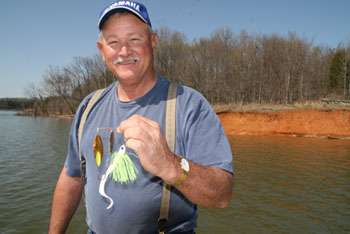
Spinnerbait Guidelines | Spinnerbait Selection Chart
“It only makes sense to me,” says Denny Gilbert as he discusses making or customizing spinnerbaits. “The better commercial models are great, but sometimes you need something special.”
Special begins with plenty of parts. Gilbert always carries three large plastic boxes full of them. In one he has wire frames and heads; in another he has skirts and trailers; and in the third he carries blades, swivels, clevises, clips, beads and whatever else he may need to make a bait from scratch or customize a commercial model.
“I fish Kerr Lake in Virginia and North Carolina regularly and compete in quite a few tournaments during the course of a year. Spinnerbaits are a great all-season lure if you choose the right one and throw it in the right place,” he says. “But you have to have a big supply. If you carry only a few, you won’t have the one you need when you need it.”
To support that proposition he points to a recent event. Gilbert and his fishing partner needed a spinnerbait that would run deep but with big, gold blades that would make a lot of disturbance and be clearly visible to the bass. None of his commercial models quite fit the bill. So, he made one.
He started with a one-ounce head on a heavy wire frame. To that he attached two huge gold-colored willowleaf blades to the bait along with a couple of bright beads. In a few minutes he had exactly what he wanted — a spinnerbait he could work slow and deep and that made lots of commotion.”You can’t buy that bait on the market. I wanted to be down deep and not moving forward very fast but I still needed to crank it to keep the blades moving. You have to build that one,” he explains.The mechanics of building a spinnerbait aren’t all that difficult. You’ll need to assemble a wire frame with a molded head; a blade or two (or more); a clevis (it attaches the upper blade to the wire arm and allows the blade to turn); a few beads and spacers; a ball bearing swivel; and a good pair of needle-nose pliers.
Slip the clevis and blade combination on the upper wire. Add a few colored beads or spacers to suit current conditions and then attach the back blade to the end of the wire with a swivel. Keep the swivel securely attached to the frame by hooking it inside a small loop in the upper wire. Use your pliers to make the loop.After that, add a plastic or pork trailer and maybe a trailer hook. You’ll be good to go.
But you don’t need to make your own spinnerbaits from scratch to be successful. There are commercial models available that will meet most — but maybe not all — of your fishing needs. And if you’re carrying lots of quality brand-name spinnerbaits with you, Gilbert recommends carrying fewer component parts in the boat and customizing only when necessary.
“Customizing a solid, high-quality spinnerbait is really simple,” he says. “You can usually change the blades in a minute or two and the skirt takes less time than that,” he explains. “Straighten the loop in the top wire with a pair of pliers. A new clevis with a new blade attached will go right on. Swap the back blade using the original swivel. Change the color and style of the beads and spacers to suit conditions.
Change skirts and trailers as required. Add a trailer hook and you’re done. Doing this will allow you to get by with a small collection of commercial spinnerbaits if that suits your fishing style or budget.”Gilbert cautions anglers to not be penny wise and pound foolish when doing any of this, however. He emphasizes that cheap clevises holding cheap blades on cheap wire rames will not help you catch fish. In fact, they’ll do just the opposite.
7. Use a trailer hook when necessary, but remember they tend to hang in heavy cover.
9. Narrow the gap between the upper arm and the hook to make the spinnerbait run faster.




